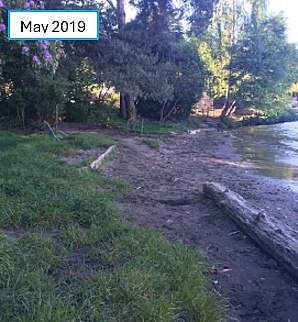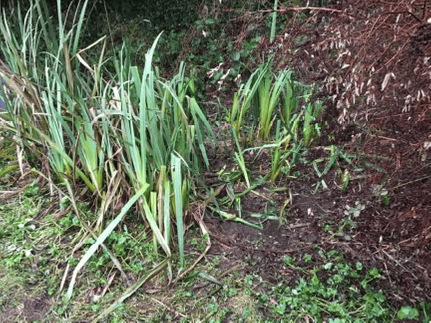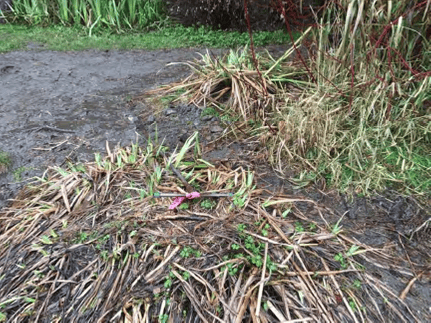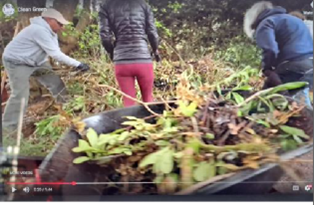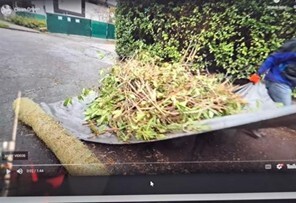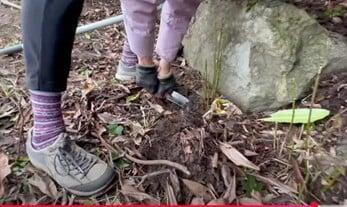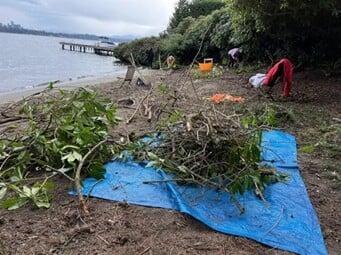Better Stewardship Needed
The Friends of Hidden Beach recently submitted an application to SDCI that will exacerbate illegal uses and degradation of the environment that the public comes to the East Harrison SSE to enjoy. The Application reads as if it is designed specifically to eliminate what is left of the wetland and shoreline ecological functions.
FOHB does not represent all voices in the community, and people are concerned about the abuse of the ecological functions of the East Harrison SSE. Pictures are worth a thousand words. Below is what the E. Harrison Street End was just a few years ago.
For years, FOHB has cut away vegetation without permits and encouraged uses at the SSE that destroy the wetland and wetland buffer. It is not legal to destroy a delineated wetland and then claim it does not exist. Such destruction is not tolerated on private property and should not be allowed here on public property.
Mountains of cutting have happened in just the last two years alone as shown below in photos and snapshots of videos by FOHB, with the last snapshot from a video showing someone digging up plants out of the wetland buffer:
April 2023
March 2023
The photo below, taken from a video by FOHB in August 2024, shows what the formerly lush area in 2017 has become today because of trampling, digging, off-leash dogs, bonfires, and vegetation removal by FOHB – nothing is left of the grasses in the wetland, just hacked away roots, eroded soils, and a leftover lawn chair.
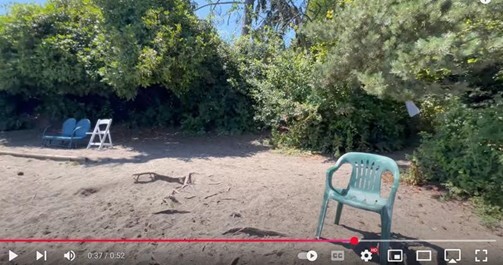
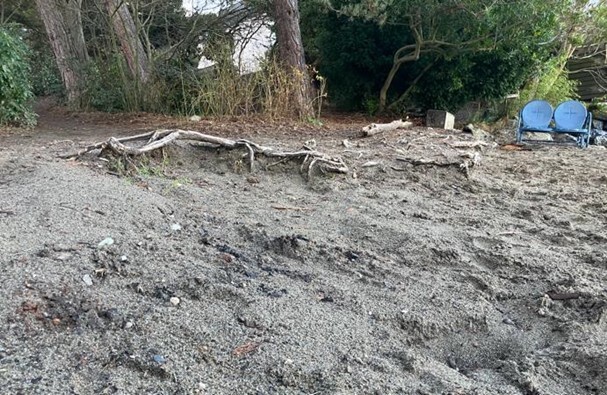
Pictures speak a thousand words. The wetland and vegetation have been severely degraded – so badly that Professional Wetland Scientist Jennifer Marriott stated in her comment letter on FOHB’s application:
“This is one of the clearest examples of documented degradation of wetland vegetation that I have observed. Many disturbed sites and wetlands lack the solid documentation of “before and after” conditions that this site possesses.”
Many people provided comments to SDCI asking for the restoration and protection of the environment at the East Harrison SSE, for example:
• “In dozens of other beautiful green places across Seattle and King County, the illegal uses and destruction of critical areas that some people are getting away with at Hidden Beach would be shut down hard by locals and regulators alike who respect: the environment, the regulations put in place to protect the environment for the enjoyment of all, and the interest and rights of neighbors.”
• “The clear cutting that has occurred this past year is unbelievable. I’m not sure who is in charge of the ‘maintenance’ of this street end but it has been more of a major renovation project than routine maintenance in my opinion. The importation of sand and bark, along with what I’m led to believe is illegal trimming of existing trees has been extraordinary, not to mention horrific. What was once an intimate charming park used by neighbors has now become something like you would experience in Miami Beach. Sadly, on many days it is like the Stan Sayers pits area during SeaFair’s hydroplane race days. I know of many neighbors (Madrona, Denny Blaine, etc.) that now steer clear of the street end on busy days due to the overcrowded circumstances. I would suggest the city demand a plan of restoration of the damaged areas to include new plantings, etc., and to provide the basis of a future maintenance plan that is not done in what currently appears to be ad hoc at best.”
• “I live near a Street End, these public spaces are slowly being destroyed since 2020 and I encourage SDCI to require that the group that contributed to its destruction. There are frequent fires, needles, underage drinking and at times, these same people get in their car and speed away causing potential danger to those that live in the area.”“We have lived in Denny Blaine for 40 years and witnessed the transformation of many small neighborhood parks into overused, unregulated, unsafe spaces. Alas, we can no longer take our grandchildren to many of the places we enjoyed with our children. The shoreline at Harrison is badly degraded, and off leash dogs run rampant. Once a small pocket park, it is now overcrowded and over run. FOHB is misguided in their plans, which violate environmental regulations and would serve to open the beach to further deterioration.”
• “My plea to the City is to recognize the unique ecology on this unique public property and require its restoration and protection by those who participated in and encouraged its destruction, led by the ‘steward’ of FOHB.”
• “When trees or shrubs frustrate FOHB’s plans, they unholster their chainsaws and cut them down or remove limbs. If growth or bushes get in the way of their paths, they remove whatever is left after the off-leash dogs have torn everything up, and start raking paths that suit their vision. None of this is done with permits or approvals, and SDCI fined FOHB and their arborist twenty thousand dollars after their latest illegal and unpermitted ‘maintenance.’
• “I ask that SDCI apply the best available science to restore and protect the wetland and wetland buffer portions of the East Harrison SSE from further degradation. The current wetland rating manual rates the wetland as a Category II wetland, which requires a 110-foot buffer. The 110-foot buffer should apply to FOHBs application, not the 50-foot buffer that FOHBs application shows. SDCI also should require mitigation for the impacts of the redevelopment and uses that FOHB has encouraged and proposes in the wetland and wetland buffer. I fully support safe and legal public access. Unfortunately, FOHBs application to develop the shoreline environment and wetland is not safe for the environment or legal under the laws that protect ecological functions along Washington' shorelines.”
• “It is past time for SDCI to follow existing law with regard to the East Harrison Shoreline Street End. The application by a local ‘protection’ group deserves close examination, given previous illegal activities such as tree cutting, brush clearing, and digging in a wetland supposed to be protected, if not enhanced. These street ends were not meant to be a destination place for large groups of people, late night parties, or the kinds of development required to support safe boating and swimming. There are accessible larger beach and swimming areas nearby. E Harrison is unique in another way in that it is comprised of a fragile yet important contributor to the ecological health of the Lake Washington's shoreline. There's been a lot of misinformation distributed of late. As a nearby resident, I'd like to see the city step up and provide a thorough and transparent assessment of the health of this piece of shoreline, the expectations about how it will be improved, the approved tactics, and the desired outcomes against which this will all be measured.”

